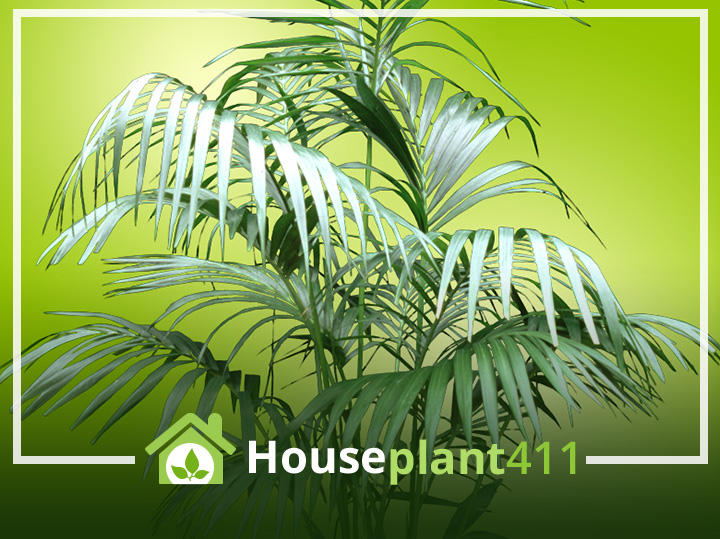About
Kenta Palm, Howea forsteriana, sometimes called a Paradise Palm, is native to Australia and Lord Howe Island in the South Pacific. It is a member of the Arecaceae palm group and a close relative of the Neanthebella Palm, the Sentry Palm (Howea Belmoreana), the Coconut Palm, and the Pygmy Date Palm. All these plants are classified as “feather palms.” Outdoors a Kentia Palm is a very large plant that can stand 35-40ft tall and 5-10ft wide and produces white flowers atop long spikes. Fruit develops on mature plants that are more than 15 years old.
Kentia Palm Description
Even when grown indoors, this palm is a very large, impressive plant that requires plenty of space; it can be as tall as 10-12 feet and as wide as 4-5ft. The wide feathery fronds (leaves) can easily be 10”-14” long. While in nature, a kentia palm has a single stem, when purchased as an indoor plant, there are multiple stems since several kentia palms are usually planted together to help the plant appear full and bushy. The fact that this is a slow growing plant and there are several plants in the pot, helps explain why a kentia palm is so expensive to purchase.
Quick Care tips for a Kentia Palm
Medium light
Over watering is the main reason a Kentia Palm dies
Provide warm temperature
Fertilize in spring and summer only
Use a sandy soil that drains quickly
Kentia Palm Problems and Causes
Brown frond tips –
Over-fertilized, chemicals in the water, dry or cold air, needs more water
Gray, brittle fronds –
Palm is over watered
Brown spots on fronds –
Leaf spot disease, extreme cold, direct sun, hard water
Pest Problems
Scale, mealy bugs, and spider mites
Conclusion
A Kentia Palm is one of the most elegant and expensive palms that can be used indoors. This is a slow growing plant that thrives in medium light; and even does well in low- light conditions if you are careful not to over water. Kentia Palms need plenty of room to grow, do not like dry air or bright sunshine, and prefer cool winter temperatures and warm, humid summers. A kentia Palm is nontoxic and safe to have around small children and pets.
Plant Care
Light
A Kentia palm can survive in low light conditions, but grows better and develops more fronds in medium indirect light.
Water
Water a Kentia palm well and then allow the top 25% of soil to dry out before watering again. Over-watering, resulting in root-rot, is the major reason Kentia palms die. Kentias, like most indoor palms, are sensitive to salt, fluoride, and chlorine in the water. Allow your water to sit out over night before using it or use distilled water if your household water has a high chemical concentration. Never use water that has passed through a softener, it is too salty.
Fertilizer
A Kentia Palm is a slow growing plant and only needs to fertilized monthly in the spring and summer when it is actively growing. Use a balanced houseplant food diluted to 1/2 the recommended strength.
Temperature
Keep the room temperature between 65 and 85 degrees for a Kentia Palm.
Humidity
A Kentia Palm does well in basic household humidity.
Pests
Spider mites and mealy bugs are the main problems. Since palm fronds are easily damaged, never use any plant product that contains alcohol. Use a biodegradable soap solution to treat houseplant pests on palm plants; If this doesn’t eliminate the, try an Insecticidal Soap or Need Oil.
Soil
Use a well-aerated potting soil that drains quickly but still retains water; add sand if the soil appears heavy and claylike.
Propagation
Kentia Palms are propagated by seeds. This is a difficult process best left to the experts.
Poisonous Plant Info
A Kentia Palm is a non-poisonous plant.
FAQ
Move your Kentia palm to better light to encourage more new growth.
Your doesn’t need more fertilizer, it needs more water. The brown tips on your palm are probably being caused by too much plant food.
Spotting on the top fronds of a kentia palm is usually the result of too much direct sun hitting the plant.
Kentia palms get brown /gray and crunchy fronds when they are over watered. Let the palm thoroughly dry out or you will lose it to root rot.

